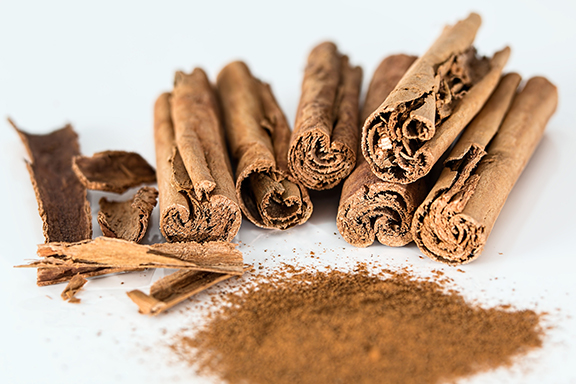
Cinnamomum sp.
Cinnamomum sp. from the family Lauraceae is a tree whose bark is harvested and dried to produce the cinnamon oil, cinnamon sticks, and cinnamon powder. Cinnamomum verum (aka Cinnamomum zeylanicum), native to Sri Lanka, is called the true cinnamon tree or Ceylon cinnamon. Ceylon is the highest grade of cinnamon. Cinnamomum burmanni (aka Indonesian cinnamon, Korintje cinnamon, Padang Cassia) is the cheapest and most common type of cinnamon (you’re most likely to see in the stores and in powder form). Cinnamomum loureiroi (aka Saigon cinnamon, Vietnamese Cassia, Vietnamese cinnamon) is found in Southeast Asia. Cinnamomum aromaticum is commonly known as Cassia cinnamon or Chinese cinnamon. It is found in Southeast Asia, southern China, and Myanmar.
Habitat/Growing Information.
Cinnamomum sp. is a rather short-lived evergreen–about 10 years. A mature tree grows to about 20 feet, but you can grow them 3-8 feet in containers. The cinnamon tree likes full to partial sun, humidity (regular rainfall like in a jungle environment), and well-drained soil that has a higher percentage of sand and silt. It grows in the USDA zones 9-11. White or green flowers (panicles or branched inflorescences) bloom in the summer.
Parts utilized.
The cinnamon tree may be harvested starting at 3 yrs old. The orange inner bark of the cinnamon tree is used to make oils, cinnamon sticks like you see in stores, and cinnamon powder. The branches can be harvested, and the tree can be cut down to the stump. The bark of the main trunk is harvested while the leaves, branches, and roots can be distilled to make cinnamon oil and essential oil preparations while oleoresins can be made via solvent extraction (Muhammad & Dewettinck, 2017).
The remnants of the cinnamon flower yield a sweet berry (aka Cassia berry) which can be used in jams/compotes or dried for tea. You’ll have to keep an eye out for them because birds love the berries! The berries (seeds inside) may also be kept to grow new plants.
Properties.
Cinnamon has been used for (but not limited to): GI distress; toothaches; colds; high blood pressures; dermatitis; and menstrual issues (Singletary, 2019). Cinnamon oil concentrate has an anesthetic/analgesic effect. Bioactive components are: cinnamaldehyde (bark); cinnamic acid; coumarin; linlool; eugenol (leaf); caryophyllene; pholyphenolpolymers; and protective properties against inflammation, oxidative stress, microbials, metabolic syndrome, high blood glucose, and high blood lipids (Ranasinghe & Galappathythy, 2016; Muhammad & Dewettinck, 2017; Singletary, 2019). In Ayurvedic medicine, cinnamon has been used for digestive, respiratory, and gynelogical issues (Ranasinghe & Galappaththy, 2016).
Cinnamon was able to prevent food from spoiling via microbial activity (Muhammad & Dewettinck, 2017). Cinnamon also exhibited antibacterial properties against: B. subtilis, S. aureus, B. cereus, E. coli, S. typhi, and P. aeruginosa (Muhammad & Dewettinck, 2017). Cinnamon also has antifungal properties against: Aspergillus, Fusarium, and Penicillium (Muhammad & Dewettinck, 2017). The essential oil from C. zeylanicum (500 ppm) inhibited growth of select species from Streptococcus, Enterococus, Acinetobacter, Enterobacter, Klebsiella, Proteus, Mycobacterium, Clostridium, Listeria, and Candida (Muhammad & Dewettinck, 2017). The most important bioactive compounds for antimicrobials were cinnamaldehyde, eugenol, linalool, limonene, and citral (Muhammad & Dewettinck, 2017).
When used moderately, cinnamon is generally safe. Coumarin (C9 H6 O2, 2H-Chromen-2-one) is an aromatic compound that can be toxic to the liver (Singletary, 2019). Levels of coumarin vary by species but generally less than 0.01 g per 1 kg of plant matter in C. zeylanicum, and 3.6 g per 1 kg of plant matter in C. cassia (Singletary, 2019).
References
- http://www.botanicalauthentication.org/index.php/Cinnamomum_aromaticum_(bark)
- https://www.cinnamonvogue.com/Types_of_Cinnamon_1.html
- https://www.thespruce.com/cinnamon-plant-care-and-growing-guide-4690725
- https://www.specialtyproduce.com/produce/Cinnamon_Tree_Berries_15608.php
- https://pubchem.ncbi.nlm.nih.gov/compound/Coumarin
Muhammad, D. R. A., & Dewettinck, K. (2017). Cinnamon and its derivatives as potential ingredient in functional food—a review. International journal of food properties, 20(sup2), 2237-2263.
Ranasinghe, P., & Galappaththy, P. (2016). Health benefits of Ceylon cinnamon (Cinnamomum zeylanicum): a summary of the current evidence. Ceylon Medical Journal, 61(1).
Singletary, K. (2019). Cinnamon: Update of Potential Health Benefits. Nutrition Today, 54(1), 42-52.
